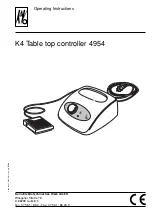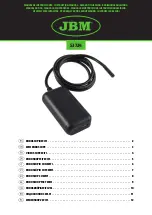
7
HOOKS
WARNING
1. Any hook that requires replacement because of excessive
bends,twists, or throat opening indicates abuse or overloading of
the puller. Therfore, other load supporting components of the puller
should be inspected for possible damage when such condiitions
are found.
2. Never repair hooks by welding or reshaping. Heat applied to the
hook will alter the original heat treatment of the hook material
and reduce the strength of the hook.
3. Never weld handles or other attachments to the hook. Heat applied
to the hook will alter the original heat treatment of the hook
material and reduce the strength of the hook.
HOOKS INSPECTION
Refers to ASME B30.10, Safety Standard for Hooks. Inspect hooks
and measure hook throat opening at least once a month. Between
regular inspections check visually daily for deformation, distortion,
twisting, damage, and missing or damaged hook latches. Inspect
as follows:
1. Measure hook throat opening from metal to metal of the hook as
shown by dimension g in Figure 2. DO NOT measure from latch to
metal. Hook must be replaced when throat opening measurement
has increased 9% over the original throat opening dimension of a
new hook, as follows:
CAPACITY
DIMENSION g
DIMENSION g
TONS
NEW HOOK
REPLACE HOOK
1/4
24mm
26mm
1/2
28mm
30mm
2. Measure hook depth at load bearing point (base, bowl or saddle)
of the hook. Hook must be replaced when wear at load bearing
point is 10% of the original depth of the hook load bearing point.
3. A bend or twist of the hook exceeding 10° from the plane of the
unbent hook requries replacement of the hook.
4. A hook latch that is missing shall be replaced.
5. A hook latch that is inoperative shall be repaired or replaced.
6. A hook with a hook latch that does not close the throat opening of
the hook shall be removed from service until the latch is replaced
or repaired.
7. Hooks having damage from chemicals, corrosion, or deformation
shall be repaired or replaced.
7
CROCHETS
AVERTIS
SEMENT
1. Le
besoin de
remplacement de
tout crochet
dû à
un excès
de courbure,
de torsade,
ou douverture
de gorge
indique
un usage
abusif ou
une surcharge
du treuil.
Vous
devez alors
inspecter les
autres composantes
porte uses
de charge
pour
déceler tout
dommage possible
lorsque vous
reperez de
telles
conditions.
2. Ne
réparez jamais
les crochets
en les
soudant ou
reprofilant.
La chaleur
appliquée auc
rochet provoquera
une modification
du traitement
thermique original
due matériel
du crochet
et
réduira la
résistance de
ce dernier
.
3. Ne
soudez jamais
les poignées
ou autre
équipement auxiliaire
au crochet.
La chaleur
appliquée au
crochet provoquera
une
modification du
traitement thermique
original du
matériel du
crochet et
réduira la
résistance de
ce dernier
.
INSPECTION
Reportez-vous à
la norme
de sécurite
B30.10 de
IASME portant
sur les
crochets. Inspectez
les crochets
et mesurez
Iouverture
de gorge
de ces
derniers au
mains une
fois par
mois. Entre
les
inspections régulières
, effectuez
des inspections
visuelles taus
les jours
pour déceler
la deformation,
Ie gauchissement,
les
torsades, Ie
dommage, ainsi
que les
loquets de
crochets
endommagés ou
manquants. Inspectez
comme suit:
1. Mesurez
Iouverture de
gorge du
crochet de
métal à
métal du
crochet, tel
quillustré par
la dimension
g de
la Figure
2.
EVITEZ de
mesurer de
loquet à
metal. Le
crochet doit
être
remplacé lorsque
la mesure
de Iouverture
de gorge
a
augmente par
plus de
9% par
rapport à
la dimension
originale
de Iouverture
de gorge
dun crochet
neuf, comme
suit:
DIMENSION 9
DIMENSIONg
CAPACITE
DUN CROCHET
REPLACEZ LE
TONNES
NEUF
CROCHET
1/4
24mm
26mm
1/2
28mm
30mm
2. Mesurez
la profondeur
du crochet
au niveau
du point
de
support (point
daccrochage) du
crochet. Le
crochet doit
être
remplacé lorsque
Iusure au
niveau du
point de
support est
de
10% de
la profondeur
originale du
point de
support du
crochet.
3. Un
crochet courbé
ou torsade
a plus
de 10º
du plan
du crochet
détendu doit
etre remplacé.





























